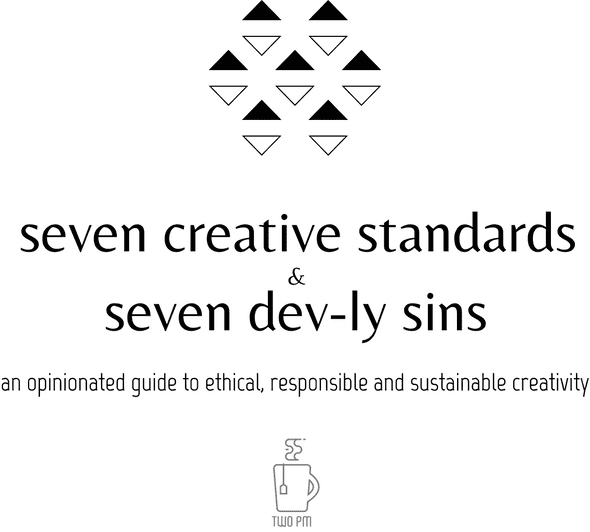Seven Standards: 2. Create Value
April 10, 2019

This is part two of our series “Seven Creative Standards and Seven Dev-ly Sins.” You can read the rest of the series here or learn more about us at twopm.studio/about.

2: Create Value
When creating something it’s easy to get carried away in the theoretical. We imagine that our idea is good just because it’s interesting. In this area I think art & design can learn a little from good old business: to look at what we do and ask ‘Why this, why now?’. The primary reason anyone consumes anything, be it media, produce etc. is that it brings value to their lives.
It is vital to the creative process to always keep the value proposition in mind. Why are you making what you make? Why would someone consume it? Who does this project positively or negatively affect? These questions can be uncomfortable and difficult to answer but they are ultimately the fundamental guiding force in a relationship between a creator and the world.

What do you mean by value?
At its most basic value is a perceived benefit: “this thing is valuable because I can see how it makes me feel good”. There are many forms of value, and none are inherently superior to others. Things we create can save users time and money, or entertain or otherwise entice them to spend both. Through our work users can learn practical and emotional lessons and can even form new relationships. These are all very valid ways to look at providing value to the user.
There’s another aspect here too, the passive value you can bring to the world at large. Your work may inspire your audience to change something about the way they live their lives and this has exponential carryover to the people that your audience spends time around. A fantastic example of this is a project like Black Panther where the experience of watching it is only a small part of the value it brings. This factor, unfortunately, goes both ways. Your work may be loved your audience who will happily compensate you but the societal impact can be very negative.
In my opinion the whole reason this is worth thinking about is the that the most effective, ethical and rewarding projects are those which can maximise value for the creator, audience and world at the same time.

What does this look like?
For entertainment this largely consists of the message and tone resonating and being engaging enough that a consumer will be happy to spend their time and in return they pay an admission or subscription price. Here the benefit to the consumer is emotional while the creator profits financially. The way this is meant to work is that by creating a more compelling piece of entertainment word will spread further and faster and more people will be willing to pay to experience it. Obviously this is not always the case in practice due to the nature of marketing but a significant proportion of creators are happy with this model.
For products, digital or physical, the value is largely tied to how much time you will be saving a user. For example you might pay for a new high-quality kitchen knife which in turn cuts down on how long it takes you to chop up vegetables. The designer makes money from the purchase and the consumer saves time. A good knife will be reviewed well and purchased by more people, maximising value.
Now, to be clear, there is a very blurry line between the ideas of “entertainment” and “product”, both can be practical and both can entertain. These are intended as illustrative examples not categorical definitions.

What doesn’t this look like?
The Second Devly Sin is Heartless Profit - benefit attained from a product at the expense of its audience.
Social media platforms are a striking example of potential value mismatch. For example, Facebook makes money through advertising impressions, which traditionally happen via more time being spent on the newsfeed (or increasingly in Messenger & Instagram). The value for user on Facebook was originally to keep in touch with their friends more easily; ideally, Facebook would let us pop on, get what we need and leave. That is maximising value for the end user.
Instead what we have is an incredibly intelligently designed system for trapping a user on the site and wasting their time to create further value for Facebook. This goes one step further where many users feel that they are actually benefiting from the “interesting” content Facebook surfaces to them, despite the fact that Facebook is actually profiting from their time and personal data. In my opinion, this is the antithesis of good design and is a failure in the relationship between author and audience. Design should create value for both the consumer and creator, otherwise the maximum benefit cannot be gained.
This touches on the subjective nature of value, who am I to say those people aren’t getting a fair value proposition from their perspective? If we can attempt to factor in negative emotions felt by comparing yourself to others on social media or shortened attention spans leading to anxious behaviour then perhaps the balance shifts again. Add to this the societal impact of everyone being glued to their phones and you’ve got even more to worry about.
You can see how this plays out, its hard to predict value in the long term and many consumers aren’t even trying to do so. I believe that as creators we have a responsibility to try and understand the far-reaching value implications of our work. We might not get it completely correct but it’s better than being in denial. When the creator’s and consumer’s interests are aligned amazing things happen. We get great works of art, world-changing inventions, happy people and healthy economies.

I urge you to keep the value of your project for yourself and others in mind as often as possible. Many design choices become trivial when viewed through the lens of maximum value for all parties. The final benefit of this approach is how you will treat yourself. There is little to be gained by wasting your own time or working on projects that do nothing to please you. Hold yourself to The Second Standard:

Demand of your projects that they benefit their audience. Seek more than novelty in your ideas; seek to value your audience and give them something of value.

This is part two of our series “Seven Creative Standards and Seven Dev-ly Sins.” You can read the rest of the series here or learn more about us at twopm.studio/about.
Written by Ben (@vivavolt) and Ricky (@iammonshushu) at TwoPM Studios in Brisbane, Australia.